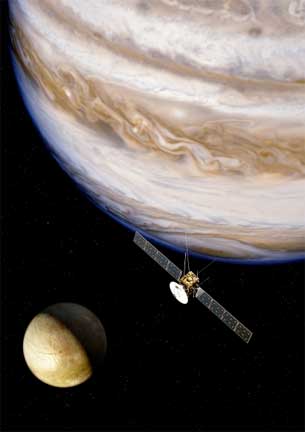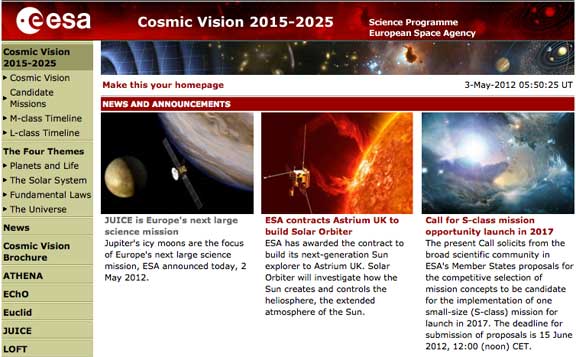
Artist's impression of JUICE, copyright: ESA/AOES
...science mission, ESA has announced. The explorer that will be sent to explore Jupiter's icy moons—JUICE—was selected over two other candidates. JUICE is the first Large-class mission selected as part of ESA's Cosmic Vision 2015-2025 program. It will be launched in 2022 from Europe's spaceport in Kourou, French Guiana, on an Ariane 5, arriving at Jupiter in 2030 to spend at least three years making detailed observations. Jupiter's diverse Galilean moons—volcanic Io, icy Europa and rock-ice Ganymede and Callisto—make the jovian system a miniature Solar System in its own right.
With Europa, Ganymede and Callisto all thought to host internal oceans, the mission will study the moons as potential habitats for life, addressing two key themes of Cosmic Vision: what are the conditions for planet formation and the emergence of life, and how does the Solar System work? JUICE will continuously observe Jupiter's atmosphere and magnetosphere, and the interaction of the Galilean moons with the gas giant planet. It will visit Callisto, the most heavily cratered object in the Solar System, and will twice fly by Europa. JUICE will make the first measurements of the thickness of Europa's icy crust and will identify candidate sites for future in situ exploration. The spacecraft will finally enter orbit around Ganymede in 2032, where it will study the icy surface and internal structure of the moon, including its subsurface ocean. Ganymede is the only moon in the Solar System known to generate its own magnetic field, and JUICE will observe the unique magnetic and plasma interactions with Jupiter's magnetosphere in detail.
This announcement is the culmination of a process started in 2004 when ESA consulted the wider scientific community to set Europe's goals for space exploration in the coming decade. The resulting Cosmic Vision 2015-2025 program identified four scientific aims. What are the conditions for life and planetary formation? How does the Solar System work? What are the fundamental laws of the Universe? How did the Universe begin and what is it made of? In 2007, a 'Call for Missions' was issued around these aims and resulted in a number of L-class missions being considered.


